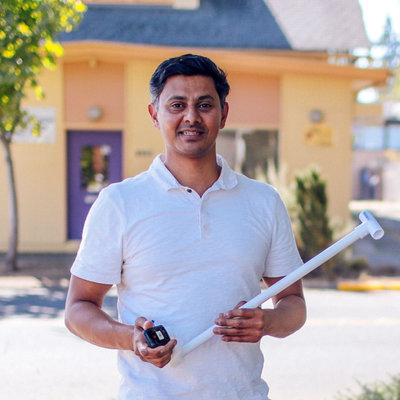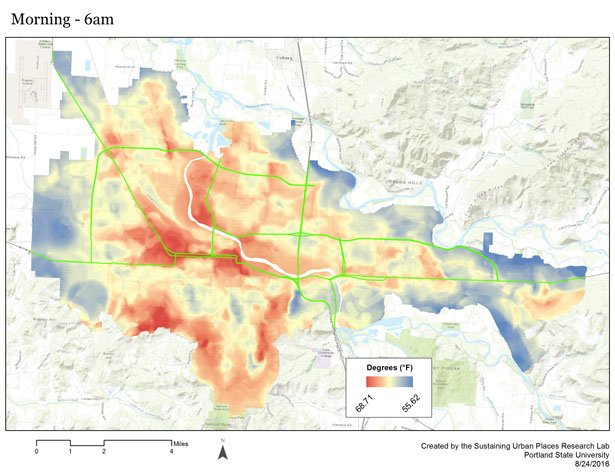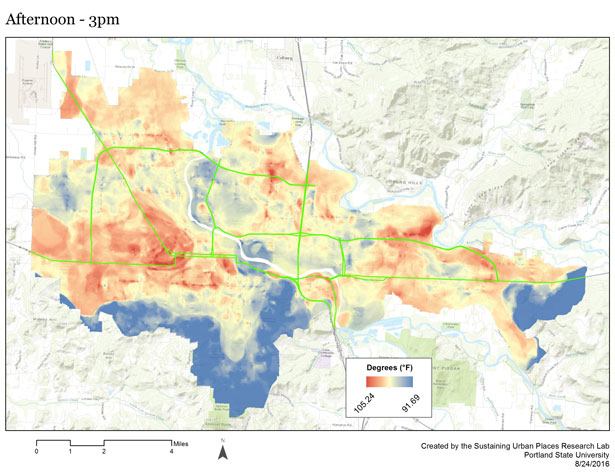
Last week’s heat wave sent Lane County residents scurrying for shade. Press releases from the city and county offered suggestions for cool places like the library or swimming pools to take cover. But for those without air conditioning or in some cases without a roof over their heads, heat waves can turn deadly.
In 2003, a heat wave that hit France killed more than 14,802 people. Most of those who died of hyperthermia were elderly people living alone in apartment buildings without air conditioning — temperatures of more than 104 degrees for seven days in a row were recorded in some areas. On Aug. 19, here in Eugene, temperatures topped 104 degrees as well, and scientists and community activists sprang into action to record the heat and to help area community members survive it.
Vivek Shandas of Portland State University came to Eugene-Springfield with a team of scientists using highly sensitive thermometers connected to GPS locators and data recorders mounted on poles outside their cars to record temperatures every one second at 6 am, 3 pm and 7 pm while driving 35 miles per hour.
One of the goals of the project, which teamed up the city of Eugene’s urban foresters, is to locate “urban heat islands” that are often 10 to 20 degrees Fahrenheit hotter than other parts of the same city.
Shandas, together with researchers Jackson Voelkel and Bill Garcia, examines the temperatures and then looks at aspects of the city such as trees, buildings and their heights, roads and other features. Shandas says the research in other cities, from Portland to Doha, Qatar, has shown that he might expect to see urban heat islands in industrial areas, along railroads and large paved parking lots. Shandas himself drove the route out near Eugene airport, an industrial area with railway lines.
Shandas says prelminary temperature data shows “a range of temperatures that are higher than we’ve seen in other cities” with an almost 14 degree difference throughout the region, ranging from 91 to 105 degrees in the afternoon, and that Eugene’s downtown is hot, compared to Portland’s, which he says is cool from shade. The researchers will be “refining the maps in the coming weeks with higher resolution data,” and then they will be able to describe what ground-level factors, from grass to tree canopy, explains the variation in temperatures.
Impacts of climate change mean that summer heat waves will be more intense and of greater magnitude and duration, Shandas says. The PSU research aims to bring together city, county, state and nonprofit entities to figure out who is more vulnerable to effects of heat islands and air pollution and what can be done to mitigate it.
Shandas says heat waves can be silent killers, and heat most often kills at night when bodies don’t regulate temperature during REM sleep. Heat compounded with the smog that often accompanies rising temperatures can adversely impact the elderly, those with heart or lung conditions and other vulnerable populations. Studies like this can help governments assess where mitigation efforts should begin. For example, planting trees can create more shade and varying building heights can create airflow.
Shandas and the information out of PSU’s Sustaining Urban Places Research Lab will in the long-term help cities plan how to better cool their citizens, but in the meantime, Shandas mentioned seeing a homeless man trying to shade himself from the sun as the researcher drove his route in the heat of the day.
Through intense volunteer efforts and donated space mainly from local churches and others, Lane County has managed to sustain the Egan Warming Centers to aid the unhoused during cold spells when temperatures drop below 30 degrees between Nov. 15 and March 3. But Shandas points out that during heat waves, many people, housed and unhoused alike, have no respite from the heat at night, a time where they are most likely to die of hyperthermia.
With climate change increasing summertime heat and causing droughts, the time has come to implement cooling centers.
Shelley Corteville, director of the Egan Warming Centers, says currently there are no plans for cooling centers; however, St. Vincent de Paul, in an effort unrelated to Egan, has been handing out hundreds of bottles of water around town during the recent heat waves.
Corteville and two volunteers filled ice chests with water bottles provided by SVdP, put them on dollies and walked around Eugene and Springfield handing the “mobile hydration” out to those in needs, including the people Corteville says she prefers to call “our neighbors without addresses” and checking in on how they are doing. “It’s a privilege to get to go out and do this,” she says.
Corteville says people she encountered were exhausted and unable to sleep in the heat, and she called in CAHOOTS (Crisis Assistance Helping Out on the Streets) twice for help. She said people also asked for food — fruit in particular. Eugene, she notes, has more water fountains than Springfield, but many smelled moldy, and she says, “Just providing a fountain is not enough.” It needs to be clean.
People with pets were also given water for their animals, she says. Other needs she encountered were shorts and clean socks. “People don’t think about our neighbors without addresses needing clothes this time of year,” she says, but without access to laundry, clothing becomes unwearable in the heat and people need protection from the sun.
While there are no plans for cooling centers, Corteville says she would love in the future to see mesh tents, maybe with misters, where the housed and unhoused alike could shelter from the heat. “We are all in this together,” she says, “and it’s important to maintain humanity.” Libraries and other cool buildings can only handle so many people. She says she would like to see the business community become part of the effort.
The research out of PSU could help any future endeavors determine the coolest places to put campsites for the unhoused, what areas of town have vulnerable populations exposed to excess heat and where future cooling centers could be if the community pulls together to create them.



For more on the PSU research on communities, air and heat islands, go to suprlab.org. To volunteer in future efforts handing out water, contact Corteville at dir.ewc@ gmail.com.